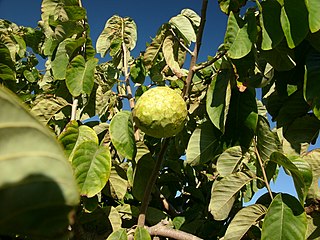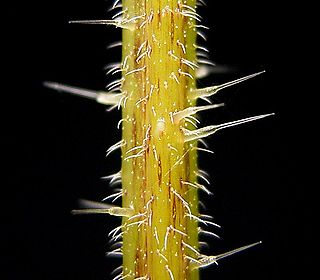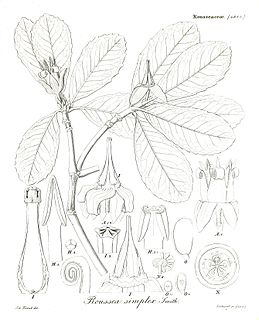
Urtica dioica, often known as common nettle, stinging nettle or nettle leaf, or just a nettle or stinger, is a herbaceous perennial flowering plant in the family Urticaceae. Originally native to Europe, much of temperate Asia and western North Africa, it is now found worldwide, including New Zealand and North America. The species is divided into six subspecies, five of which have many hollow stinging hairs called trichomes on the leaves and stems, which act like hypodermic needles, injecting histamine and other chemicals that produce a stinging sensation upon contact. The plant has a long history of use as a source for traditional medicine, food, tea, and textile raw material in ancient societies.

Urtica is a genus of flowering plants in the family Urticaceae. Many species have stinging hairs and may be called nettles or stinging nettles, although the latter name applies particularly to Urtica dioica.

The cherimoya, also spelled chirimoya and called chirimuya by the Inca people, is an edible fruit-bearing species of the genus Annona from the family Annonaceae. They were believed to be native to Colombia, Ecuador, Peru, Bolivia and Chile, spreading through cultivation to the Andes and Central America. However, they are now known to originate in Central America. Cherimoya is grown in tropical regions throughout the world, as well as Spain, where it is widely consumed and grown in the southern provinces of Granada and Málaga. It is in the same genus, Annona, as soursop.

Salix caprea is a common species of willow native to Europe and western and central Asia.

Urtica ferox, commonly known as tree nettle, or ongaonga in Māori, is a nettle that is endemic to New Zealand. It is sometimes known as "Taraonga", "Taraongaonga" or "Okaoka". Unlike other herbaceous species in the genus Urtica, ongaonga is a large woody shrub. It has woody stems and unusually large stinging spines that can result in a painful sting that lasts several days. The shrub can grow to a height of 3 m (9.8 ft) with the base of the stem reaching 12 cm (4.7 in) in thickness.

Pilea pumila, commonly known as clearweed, is an edible herbaceous plant in the nettle family (Urticaceae). It is native to Asia and eastern North America, where it is broadly distributed.
This page provides a glossary of plant morphology. Botanists and other biologists who study plant morphology use a number of different terms to classify and identify plant organs and parts that can be observed using no more than a handheld magnifying lens. This page provides help in understanding the numerous other pages describing plants by their various taxa. The accompanying page—Plant morphology—provides an overview of the science of the external form of plants. There is also an alphabetical list: Glossary of botanical terms. In contrast, this page deals with botanical terms in a systematic manner, with some illustrations, and organized by plant anatomy and function in plant physiology.
This glossary of botanical terms is a list of definitions of terms and concepts relevant to botany and plants in general. Terms of plant morphology are included here as well as at the more specific Glossary of plant morphology and Glossary of leaf morphology. For other related terms, see Glossary of phytopathology and List of Latin and Greek words commonly used in systematic names.
Aiphanes deltoidea is a species of palm which is native to northeastern South America.

Dendrocnide photinophylla, the shining-leaved stinging tree, is a rainforest tree of eastern Australia. It occurs from near the Colo River northwest of Sydney to Cooktown in tropical Queensland. A versatile species, it occurs in many different rainforest types. The specific epithet photinophylla translates to shining leaf. The generic name translates to stinging tree.

Typha minima, common name dwarf bulrush or miniature cattail or least bulrush, is a perennial herbaceous plant belonging to the Typhaceae family.
Urtica urentivelutina is a species of the genus Urtica. This species is closely related to U. macbridei, but differs in its much denser and longer indument, especially on the stipules and the presence of stinging hairs on the perigon of the female flowers. The leaves are densely pubescent and also irregularly bullate between the veins, which is a character not found in other Peruvian species.

Cnidoscolus urens is a perennial, tropical American stinging herb of the family Euphorbiaceae, and is one of some 100 species belonging to the genus Cnidoscolus. The plant is locally known as 'bull nettle', 'spurge nettle', 'bringamosa' and 'mala mujer'.

A stinging plant or a plant with stinging hairs is a plant with hairs (trichomes) on its leaves or stems that are capable of injecting substances that cause pain or irritation.

Carex pulicaris, the flea sedge, is a species of sedge in the genus Carex native to Europe.
Drakaea micrantha, commonly known as the dwarf hammer orchid is a species of orchid endemic to the south–west of Western Australia. It is similar to other hammer orchids in that it is pollinated by a single species of male thynnid wasp using sexual deception. The orchid's labellum is similar in shape and scent to a flightless female thynnid wasp. It has a single silvery-grey, heart-shaped leaf with prominent green veins and a stem up to 30 centimetres (12 in) long. The species is only known from a scattered populations in the south west of the state and has been declared "vulnerable" by the Australian government and "threatened" by the government of Western Australia.

Roussea simplex is a woody climber of 4–6 m high, that is endemic to the mountain forest of Mauritius. It is the only species of the genus Roussea, which is assigned to the family Rousseaceae. It has opposing, entire, obovate, green leaves, with modest teeth towards the tip and mostly pentamerous, drooping flowers with yellowish recurved tepals, and a purse-shaped orange corolla with strongly recurved narrowly triangular lobes.

Laportea grossa, or spotted nettle, is an African plant in the family Urticaceae, and one of 31 species in the genus. This species occurs in shady places in coastal and escarpment forests, closed woodland and on streambanks from George through the Eastern Cape, KwaZulu-Natal to southern Mozambique. Young leaves of this species are cooked and eaten as a vegetable.

Orthonotus rufifrons is a species of plant bugs belonging to the family Miridae.

Heterogaster urticae, common name nettle ground bug, is a species of true bug in the family Heterogastridae.














